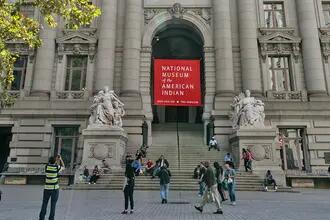
Photo Credit: OcusFocus-ThinkstockPhotos
Collapse of Lehman Brothers proves a bank's size isn't all that matters
Darius Palia, a finance professor at Rutgers Business School, believes financial industry regulators have to be careful not to primarily look at the size of an institution when assessing the potential impact its failure would have on the industry. Based on the events that occurred after the collapse of Lehman Brothers in 2008, this is a limitation of rule-making and implementation under Dodd-Frank, according to Palia.
The implications of Dodd-Frank rule-making and implementation and the insights gained from the financial crisis of 2008 will be discussed during a conference hosted by the Financial Institutions Center at Rutgers Business School on November 9. Palia is the founding director of the Financial Institutions Center. Please register to attend (seating is limited) if you are interested in shaping the post-election debate on financial regulation.
Palia on one of the lessons of Lehman Brothers:
Had Lehman Brothers been bailed out or wound down by regulators, the financial crisis that occurred would not have been as large. Of course, it is easy to say that now, four years later. But there is an important lesson from Lehman that financial regulators need to pay attention to: Large financial institutions certainly matter, but size is not the primary criteria to determine systemic risk in the financial industry. How interconnected a financial institution is just as important, as Lehman Brothers showed.
In September 2008, Lehman Brothers had $639 billion in assets when it filed for bankruptcy. Compared to Goldman Sachs (over $1 trillion in assets), JP Morgan Chase (over $2 trillion in assets), and Citigroup (over $2 trillion in assets), Lehman didn’t compare in size. Yet, one of the lessons learned from Lehman Brothers is that nonbank financial companies that are highly interconnected to the banking system are also systemically very important.
Therefore, the Financial Stability Oversight Council created by Dodd-Frank, which designates systemically important financial institutions, should be careful not to focus primarily on the size of financial institutions. They should also check how interconnected financial institutions are to each other. If there are many smaller financial institutions that are interconnected through the shadow banking system to large financial institutions, then contagion could spread to large firms as well.
If you look at all the indicators of inter-bank lending, especially the VIX, a volatility index, you will see that on September 15, 2008, when Lehman announced it would go bankrupt, the index spiked. With Bear Sterns, it spiked a bit, but the Fed encouraged JP Morgan Chase to takeover Bear and it came down again. So basically these indicators are like a medical doctor looking at the symptoms of a patient. It’s not the sickness itself, but signs of one. That shows you why Lehman was so significant; it froze a lot of credit markets, especially the asset-backed commercial paper market.
It was a classic bank run, but on the shadow banking system. The markets didn’t know what other collateral, which consisted of mortgage-backed securities, was not of good quality. Everybody asked for collateral at the same time so there was no interbank lending. As soon as that happened in the asset-backed commercial paper market, a lot of the repos, which similarly are interbank instruments of lending, also froze. One of the lenders to the repo and asset-backed commercial market are the money market mutual funds and that froze. There was a cascading effect in the short-term shadow banking system.
The pattern in a bank run is as follows: If you see a line at a bank, you don’t know whether the bank is bad or good, so you stand in line to get your deposit money out. So it is a self-fulfilling equilibrium. But FDIC insurance (created in the Great Depression) stops the panic in the demand deposit market. You can think of this crisis happening in the commercial paper, money market fund, and repo markets. There is no FDIC insurance in this shadow banking system. You don’t know whether this shadow bank is bad. So everyone starts to ask for their collateral, resulting in a market freeze.
I don’t think people really knew how interconnected Lehman was. Post collapse it was easier to see.
Another analogy to help think about it – how healthy is our traffic system and what are we doing to try to minimize congestion. There’s going to be a lot more congestion in the large cities, so you can say these are important areas, but what if there is a crucial road somewhere that connects to the city, but you don’t know that road very well so you don’t monitor it as much. Finding out what these different traffic patterns are and monitoring them is very important for the regulators.
How to map that infrastructure is a difficult issue. There are all of these transactions between firms that don’t happen through an exchange so it is harder to be monitored. They need to know what these bilateral transactions are. They do not know that yet. With this huge financial economy, they have to watch where a possible pile up could occur, that could translate into higher systemic risks.
That is why the idea of interconnectedness is an important issue.
Press: For all media inquiries see our Media Kit


